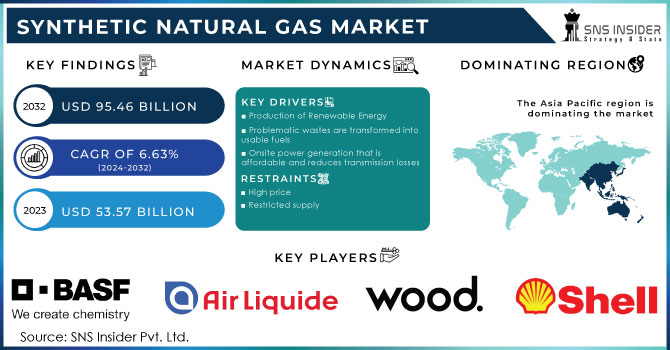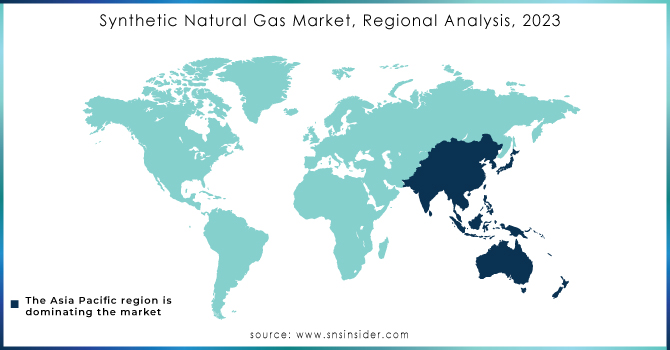Synthetic Natural Gas Market Report Scope & Overview:

Get More Information on Synthetic Natural Gas Market - Request Sample Report
The Synthetic Natural Gas Market size was valued at USD 53.57 billion in 2023 and is expected to grow to USD 95.46 billion by 2032 and grow at a CAGR of 6.63% over the forecast period of 2024-2032.
Syngas, sometimes referred to as synthetic gas, producer gas, or synthesis gas, can be created from a range types distinct carbon-containing compounds. Biomass (wood gas), plastics, coal, municipal garbage, and other resources may be among them. Many homes in the past relied on town gas to supply them with gas.
The 20th century saw industrialization in Europe and other developed nations. To improve system efficiency, petrol engines that burn syngas as fuel can be set up in a combined heat and power arrangement. Natural gas can be replaced by synthetic natural gas, which is produced from coal and is compatible for transmission through natural gas pipes. This gas is natural replacement must have at least 95% methane. The creation of synthesis gas, commonly known as syngas, is a first stage in the process of producing synthetic natural gas.
Due to its widespread usage in household, business, and industrial settings, natural gas is a significant part of the global energy supply. However, because there is a limited supply, synthetic natural gas is desired in areas where there is a dearth or lack of natural gas. Given that it exhibits natural gas-like combustion properties, this kind of natural gas is desirable.
MARKET DYNAMICS
KEY DRIVERS:
-
Production of Renewable Energy
-
Problematic wastes are transformed into usable fuels
-
Onsite power generation that is affordable and reduces transmission losses
-
Lowering of carbon dioxide emissions
RESTRAIN:
-
High price
-
Restricted supply
It is anticipated that high startup costs for SNG plants and rising fossil fuel prices would restrain the market for synthetic natural gas. SNG is a medium- to long-term solution with a broad use in the manufacture of bio-SNG. Similar to how SNG is created, SNG is also produced by the gasification of biomass, such as forestry waste or energy crops.
OPPORTUNITY:
-
Technology for underground coal gasification
-
Government investing in creation of renewable energy sources.
An increase in government measures to heavily invest in the creation of renewable energy sources is needed to reduce carbon emissions, provide a reliable supply of energy, and assure waste management ingenuity. predicted to drive the worldwide market for synthetic natural gas. However, creating an enterprise comes with a great expense.
CHALLENGES:
-
Composition of synthetic gas is highly depending upon gasifier
The inputs to the gasifier have a significant impact on the syngas's composition. Tars, hydrogen concentrations, and moisture are just a few of the syngas constituents that present problems that need to be dealt with right away. Methane, the typical fuel for gas engines, burns much more slowly than hydrogen gas does. Under normal conditions, the possibility of pre-ignition, banging, and engine backfiring would result from the engine's cylinders burning fuel more quickly. The engine has undergone a variety of technological changes to address this issue, and its output has been decreased to between 50 and 70 percent of what it would normally produce while running on natural gas.
IMPACT OF RUSSIAN UKRAINE WAR
The Russia-Ukraine conflict is resetting the energy industry, with natural gas becoming a global and linked market that is impacted by dynamics and events that go well beyond its conventional physical limitations, something akin to what oil was for decades.
Compared to merely 19% in 2021, LNG's contribution to the supply of gas to Europe increased to 33% in 2022, according to data from S&P Global Commodity Insights. Asian LNG prices are all exhibiting signs of increasing higher correlation.
KEY MARKET SEGMENTS
By Gasifier
-
Moving Bed Gasifier
-
Fluidized Bed Gasifier
-
Entrained Flow Gasifier
-
Others
By Technology
-
Steam Reforming
-
Partial Oxidation
-
Autothermal Reforming
-
Combined or Two-step Reforming
-
Biomass Gasification
By Feedstock
-
Natural Gas
-
Coal
-
Biomass/Waste
-
Others
By Application
-
Power Generation
-
Chemicals
-
Others
REGIONAL ANALYSIS
The Asia Pacific market is seeing considerable growth because to an increase in demand for SNG in nations like China, Japan, and India. Major markets in the Middle East, Africa, and Latin America are also share of the market for synthetic natural gas. This is explained by the rise in demand for SNG in important markets including industrial and commercial. Due to the increased use of alternatives and other factors, the synthetic natural gas market in North America is predicted to grow at a rapid rate over the projected period. sources of renewable energy in the United States and Canada.
Asia-Pacific led the worldwide syngas market share. Due to an increase in demand from the chemical sector, particularly from refineries market for Syngas.

Need any customization research on Synthetic Natural Gas Market - Enquiry Now
REGIONAL COVERAGE:
North America
-
US
-
Canada
-
Mexico
Europe
-
Eastern Europe
-
Poland
-
Romania
-
Hungary
-
Turkey
-
Rest of Eastern Europe
-
-
Western Europe
-
Germany
-
France
-
UK
-
Italy
-
Spain
-
Netherlands
-
Switzerland
-
Austria
-
Rest of Western Europe
-
Asia Pacific
-
China
-
India
-
Japan
-
South Korea
-
Vietnam
-
Singapore
-
Australia
-
Rest of Asia Pacific
Middle East & Africa
-
Middle East
-
UAE
-
Egypt
-
Saudi Arabia
-
Qatar
-
Rest of Middle East
-
-
Africa
-
Nigeria
-
South Africa
-
Rest of Africa
-
Latin America
-
Brazil
-
Argentina
-
Colombia
-
Rest of Latin America
KEY PLAYERS
ROYAL DUTCH SHELL PLC., SynGas Technology LLC, John Wood Group, Syngas Energy Holdings, BASF SE, Air Liquide, Air Products and Chemicals Inc., SIEMENS AG, The Linde Group, Sasol Limited, and other players are listed in a final report.
| Report Attributes | Details |
| Market Size in 2023 | US$ 53.57 Bn |
| Market Size by 2032 | US$ 95.46 Bn |
| CAGR | CAGR of 6.63% From 2024 to 2032 |
| Base Year | 2023 |
| Forecast Period | 2024-2032 |
| Historical Data | 2020-2022 |
| Report Scope & Coverage | Market Size, Segments Analysis, Competitive Landscape, Regional Analysis, DROC & SWOT Analysis, Forecast Outlook |
| Key Segments | • By Gasifier (Moving Bed Gasifier, Fluidized Bed Gasifier, Entrained Flow Gasifier, Others) • By Technology (Steam Reforming, Partial Oxidation, Autothermal Reforming, Combined or Two-step Reforming, Biomass Gasification) • By Feedstock (Natural Gas, Coal, Biomass/Waste, Others) • By Application (Power Generation, Chemicals, Others) |
| Regional Analysis/Coverage | North America (US, Canada, Mexico), Europe (Eastern Europe [Poland, Romania, Hungary, Turkey, Rest of Eastern Europe] Western Europe] Germany, France, UK, Italy, Spain, Netherlands, Switzerland, Austria, Rest of Western Europe]). Asia Pacific (China, India, Japan, South Korea, Vietnam, Singapore, Australia, Rest of Asia Pacific), Middle East & Africa (Middle East [UAE, Egypt, Saudi Arabia, Qatar, Rest of Middle East], Africa [Nigeria, South Africa, Rest of Africa], Latin America (Brazil, Argentina, Colombia Rest of Latin America) |
| Company Profiles | ROYAL DUTCH SHELL PLC., SynGas Technology LLC, John Wood Group, Syngas Energy Holdings, BASF SE, Air Liquide, Air Products and Chemicals Inc., SIEMENS AG, The Linde Group, Sasol Limited |
| Key Drivers | • Production of Renewable Energy • Problematic wastes are transformed into usable fuels • Onsite power generation that is affordable and reduces transmission losses • Lowering of carbon dioxide emissions |
| Market Restraints | • High price • Restricted supply |

